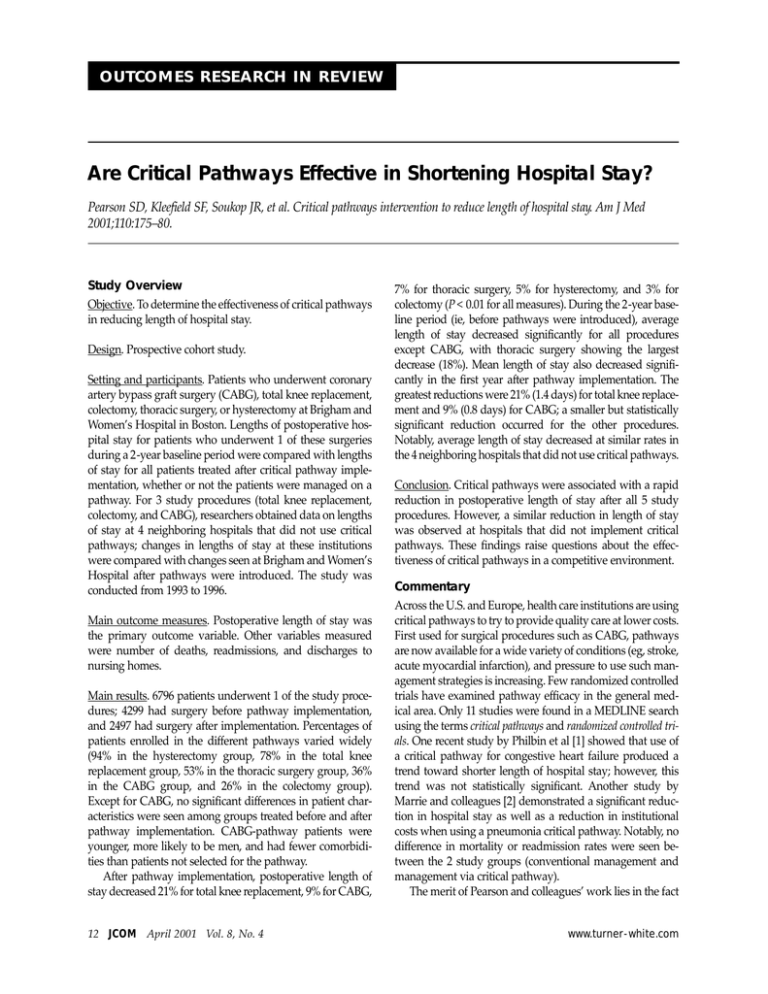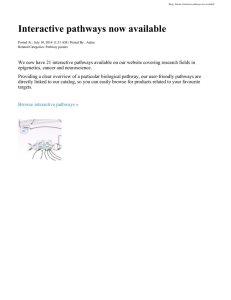
OUTCOMES RESEARCH IN REVIEW
Are Critical Pathways Effective in Shortening Hospital Stay?
Pearson SD, Kleefield SF, Soukop JR, et al. Critical pathways intervention to reduce length of hospital stay. Am J Med
2001;110:175–80.
Study Overview
Objective. To determine the effectiveness of critical pathways
in reducing length of hospital stay.
Design. Prospective cohort study.
Setting and participants. Patients who underwent coronary
artery bypass graft surgery (CABG), total knee replacement,
colectomy, thoracic surgery, or hysterectomy at Brigham and
Women’s Hospital in Boston. Lengths of postoperative hospital stay for patients who underwent 1 of these surgeries
during a 2-year baseline period were compared with lengths
of stay for all patients treated after critical pathway implementation, whether or not the patients were managed on a
pathway. For 3 study procedures (total knee replacement,
colectomy, and CABG), researchers obtained data on lengths
of stay at 4 neighboring hospitals that did not use critical
pathways; changes in lengths of stay at these institutions
were compared with changes seen at Brigham and Women’s
Hospital after pathways were introduced. The study was
conducted from 1993 to 1996.
Main outcome measures. Postoperative length of stay was
the primary outcome variable. Other variables measured
were number of deaths, readmissions, and discharges to
nursing homes.
Main results. 6796 patients underwent 1 of the study procedures; 4299 had surgery before pathway implementation,
and 2497 had surgery after implementation. Percentages of
patients enrolled in the different pathways varied widely
(94% in the hysterectomy group, 78% in the total knee
replacement group, 53% in the thoracic surgery group, 36%
in the CABG group, and 26% in the colectomy group).
Except for CABG, no significant differences in patient characteristics were seen among groups treated before and after
pathway implementation. CABG-pathway patients were
younger, more likely to be men, and had fewer comorbidities than patients not selected for the pathway.
After pathway implementation, postoperative length of
stay decreased 21% for total knee replacement, 9% for CABG,
12 JCOM April 2001 Vol. 8, No. 4
7% for thoracic surgery, 5% for hysterectomy, and 3% for
colectomy (P < 0.01 for all measures). During the 2-year baseline period (ie, before pathways were introduced), average
length of stay decreased significantly for all procedures
except CABG, with thoracic surgery showing the largest
decrease (18%). Mean length of stay also decreased significantly in the first year after pathway implementation. The
greatest reductions were 21% (1.4 days) for total knee replacement and 9% (0.8 days) for CABG; a smaller but statistically
significant reduction occurred for the other procedures.
Notably, average length of stay decreased at similar rates in
the 4 neighboring hospitals that did not use critical pathways.
Conclusion. Critical pathways were associated with a rapid
reduction in postoperative length of stay after all 5 study
procedures. However, a similar reduction in length of stay
was observed at hospitals that did not implement critical
pathways. These findings raise questions about the effectiveness of critical pathways in a competitive environment.
Commentary
Across the U.S. and Europe, health care institutions are using
critical pathways to try to provide quality care at lower costs.
First used for surgical procedures such as CABG, pathways
are now available for a wide variety of conditions (eg, stroke,
acute myocardial infarction), and pressure to use such management strategies is increasing. Few randomized controlled
trials have examined pathway efficacy in the general medical area. Only 11 studies were found in a MEDLINE search
using the terms critical pathways and randomized controlled trials. One recent study by Philbin et al [1] showed that use of
a critical pathway for congestive heart failure produced a
trend toward shorter length of hospital stay; however, this
trend was not statistically significant. Another study by
Marrie and colleagues [2] demonstrated a significant reduction in hospital stay as well as a reduction in institutional
costs when using a pneumonia critical pathway. Notably, no
difference in mortality or readmission rates were seen between the 2 study groups (conventional management and
management via critical pathway).
The merit of Pearson and colleagues’ work lies in the fact
www.turner-white.com
OUTCOMES RESEARCH IN REVIEW
that they conducted a prospective study at different centers,
although the study was observational and not experimental.
One notable problem is that all institutions included in the
study were large academic centers; it would have been interesting to compare outcomes with other centers in the New
England area that do not have a house staff or affiliation with
a medical school. Also problematic was the high number of
hysterectomy patients enrolled in the pathway (94%); the
fact that numbers were lower for the other surgery groups
introduces the risk of selection bias. In their discussion, the
authors do mention this discrepancy but do not provide an
explanation. Study design focused on efficiency, and the
question of whether overall mortality was affected or if patient satisfaction improved among those entered in a pathway remains unclear.
Applications for Clinical Practice
Based on results from this study, no association can be made
between reduction in length of stay after surgeries such as
CABG, hysterectomy, colectomy, total knee replacement, and
thoracic surgery and use of critical pathways. Critical pathways seem to provide a framework allowing for consistent
care delivery. There is a great need for further studies examining the effectiveness of critical pathways in general, particularly their effects on morbidity and mortality. At this time,
when decisions are made about whether or not to implement
a critical pathway, the same rigorous criteria used for assessing the efficacy of any other intervention should be applied.
References
1. Philbin EF, Rocco TA, Lindenmuth NW, et al. The results of
a randomized trial of a quality improvement intervention in
the care of patients with heart failure. The MISCHF Study
Investigators. Am J Med 2000;109;443–9.
2. Marrie TJ, Lau CY, Wheeler SL, et al. A controlled trial of a
critical pathway for treatment of community-acquired pneumonia. CAPITAL Study Investigators. Community-Acquired
Pneumonia Intervention Trial Assessing Levofloxacin. JAMA
2000;283:749–55.
Copyright 2001 by Turner White Communications Inc., Wayne, PA. All rights reserved.
www.turner-white.com
Vol. 8, No. 4 April 2001 JCOM 13



